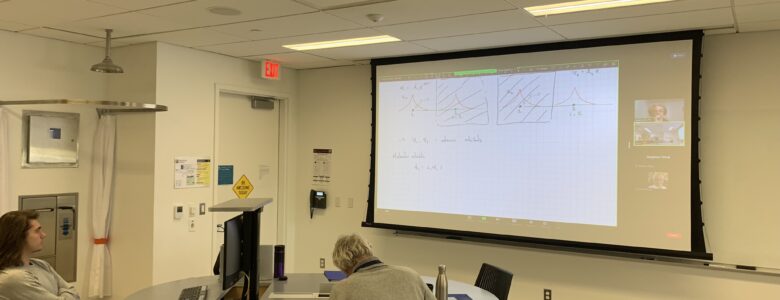By Elijah Johnson and Rob McCullough
Sometimes, it’s the small things that can lead to unique discoveries and change the world. Today’s microchip, even one as small as a pinhead, is more powerful than the computers that took us to the moon. Our powers of observation are increasing as we develop new tools to zoom in just a little more.
Sometimes those tools are massive Hadron Colliders, and sometimes they are new theories, equations, and computational methods. A group of UM-Flint undergraduates is examining whether the IBM Quantum Computer can further our understanding of the different shapes that molecules take when they form. The group is being led by James Alsup, associate professor of physics. They are using Python, as well as IBM’s own Python library, Qiskit, to design and run simulations and quantum computing calculations of the nearly 100-year-old classical chemistry equations like Schrodinger’s with large matrix inputs.
“I’m trying to build a toolbox for solving how molecules structure themselves,” said Alsup about the project. He hinted at many possible benefits to understanding these structures more precisely. Deepening this knowledge could help us better understand how molecules behave at various energy states, which Alsup indicates could help engineers to more precisely fabricate nanoscale materials, among other possible benefits.
Running the equations in matrices, sets of numbers arranged in rows and columns that represent 3D space) allows them to connect theory with reality a bit better. Physicists have long done these calculations with a simplifying assumption that the particles have no spin. This is mostly because we couldn’t calculate the equations with that additional factor involved. Further, the ‘many-body problem’ limits the size of the molecules we can study with our classical mathematical formulas because the variables increase exponentially as the number of particles increases.
These equations are all built on probabilities, and the quantum simulator runs them over 1,000 times and kicks back another level of probability to the results. Zachary Jasper, one of the students involved in the Quantum Group, says that this “gives much more precision to address the variable nature of measurements.”
Jasper is working alongside fellow physics majors Kedree Profitt and Stephen Vitek. Profitt wanted to be involved in research regarding quantum computation since the start of his college career mainly because “it seems like it would be extremely useful for the future of science.” Once he learned that Alsup was starting this project, he immediately expressed interest and joined. According to Profitt, “joining the quantum group put me on the path to choosing physics as a major. It’s put my life on such a great path.”
Proffit talked about the experience of being a part of the group. “We would have these meetings where we just keep asking questions and trying out algorithms. Like, ‘this worked over here. How can we change it to also work over here?’ It felt like a lot of useless postulating, and then eureka moments would follow. It was great. It was real problem solving, and as a group, so that was a lot of fun.” Proffit adds that he loves working on this project because it is helping us to “fundamentally change our solutions for some unique, exponentially difficult problems with the hope that our ability to fabricate bigger quantum chips improves in a similar fashion to Moore’s law, which is beginning to run into limitations with binary computing.”
When Jasper joined the group, he already had two other major research projects under his belt, making this his third since he started at the University of Michigan – Flint. He joined the group due to his passion for learning new things about the way the world works. Jasper just kept chasing curiosity with Alsup going back to his first year at UM-Flint. “Honestly,” Jasper said, “when I first got involved with it, I didn’t know anything about what was going on, but I found general relativity exorbitantly interesting.” This time around, everyone is learning something new, as they forge new territory together.
In this first step of the project, they are building out a program to test a simple hydrogen molecule and testing against known values from the classical computations. When they get this locked down, they will start testing the bounds of how precisely we can know the structure of molecules.
